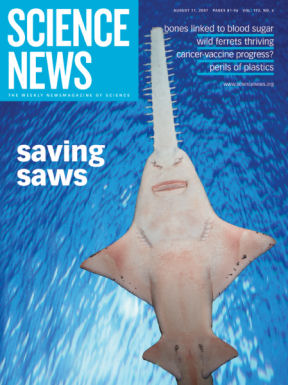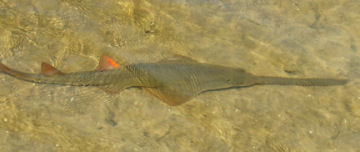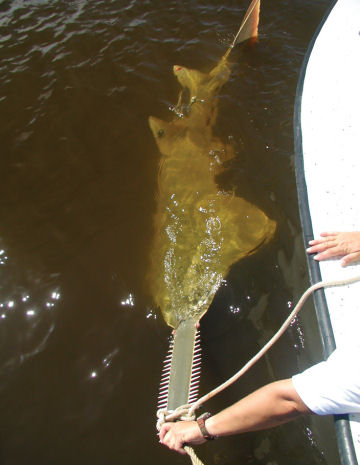The sawfish features one of Mother Nature’s oddest designs. Its flat snout resembles a chain saw with dozens of toothlike minidaggers. When the predator encounters a school of fish, it slashes its saw from side to side. As the injured quarry flutters in the water, the sawfish hoists its snout skyward and vacuums in dinner.





Sawfish can grow to 6 meters or more in length. Even newborn pups have a commanding presence. Born live, 6 to 12 at a time, each pup enters the world at almost a meter long, toothy saw in place.
These predators tend to inhabit coastal bays and lagoons. However, they can be found inland as well, cruising brackish rivers and even the occasional freshwater lake.
Sawfish became a powerful symbol in many cultures. Aztecs revered this cousin of the shark as an “Earth monster.” Some Asian shamans still brandish its toothy snout in exorcisms and other ceremonies to repel demons and disease. Chinese chefs prize sawfish fins for a luxury soup.
For millennia, warm coastal waters around the world teemed with these mighty predators. Over the past 2 centuries, however, fishing fleets with ever-growing nets have snagged countless numbers of the behemoths—mostly unintentionally. Considering the fish a nuisance, fishers gave little thought to extracting the sawfish and returning them to the sea alive. Eventually, a trophy market developed for the animals’ awesome snouts.
More recently, sawfish have been disappearing because of a strong and growing market in Asia for their fins. Owing to their scarcity, a pair of those fins can cost up to $3,000 in some Asian specialty markets today.
Even among biologists, these fish were “never on the radar screen,” says John Carlson of the National Marine Fisheries Service in Panama City, Fla. Not surprisingly, he says, their virtual disappearance in the 1970s went unnoticed.
No one knows the full effects of waning sawfish numbers on coastal ecosystems, largely because little research was performed on the fish while they were still dominant predators.
Beginning next month, however, all seven of the world’s known species of sawfish will gain protection under a United Nations–administered treaty. The Convention on the International Trade in Endangered Species, or CITES, will ban international sales of sawfish, dead or alive, whole or in pieces. The goal is to motivate fishers to release every sawfish that they capture.
Biologists and marine conservationists hope the move is coming soon enough for the populations to make comebacks. Although most sharks and shark relatives are overexploited, “I don’t think you’d get any argument that sawfish are the most endangered,” says Sonja Fordham of the Ocean Conservancy, based in Washington, D.C.
Bio incognito
Sawfish are rays, and as such, they’re essentially flattened sharks with wings. Like other shark relatives, rays mature slowly and reproduce at immensely lower rates than most fish do. This makes the animals especially slow to recover from overfishing.
The result is that sawfish have been snagged by fishing fleets faster than they can reproduce.
Records from just one region of Florida, near Cape Canaveral, illustrate the magnitude of fishing’s impacts. A 19th-century fish survey there identified sawfish as “among the most abundant species in the Indian River system.” One local mullet fisherman reported catching 300 sawfish in a single season. But when biologists surveyed the Indian River region in 1981, not a single sawfish specimen turned up.
Two sawfish species, smalltooths and largetooths, were once widespread along the Western Atlantic from Mexico to New York. Today, remnant North American populations of the smalltooth species (Pristis pectinata) persist in south Florida and the Bahamas. Total population numbers have fallen by an estimated 90 percent from prefishing abundances. Largetooth sawfish (Pristis perotteti) haven’t been sighted in North America since the 1970s.
In 1997, recognizing that sawfish populations had crashed globally, U.S. biologists proposed protecting these fish under CITES. A committee convened under the treaty rejected the proposal, however, for lack of proof that international trade was damaging sawfish populations.
The following year, the Ocean Conservancy petitioned to have the smalltooth species added to the U.S. Endangered Species List. That’s when U.S. scientists learned that few data of any kind existed for sawfish anywhere. “This fish had never been formally studied in the United States,” notes Tonya Wiley of the Mote Marine Laboratory in Sarasota, Fla. “We didn’t know such basic things as where they live, what habitat they use, how often they reproduce, how many young they have—even what age sawfish are when they reach sexual maturity.”
Wiley and others began poring over decades’ worth of news accounts and scientific-journal articles that mention the fish. The researchers learned, for example, that shrimp trawlers in the Gulf of Mexico reported large accidental catches into the 1960s. Then, during just a 5-year period, reported sawfish catches fell to zero.
In 2001, Carlson’s research team and the Mote Marine Laboratory initiated collaborative field studies of sawfish. Their findings confirmed the animals’ dire status.
“We don’t have any hard numbers on how many remain,” Wiley says, “but our guesstimate is that there are maybe 3,000 to 6,000” in U.S. waters. In 2003, the smalltooth sawfish won the dubious distinction of being the first animal that can spend its entire life in the ocean to be put on the U.S. Endangered Species List.
Its largetooth cousin is now considered extinct in the United States, but small populations remain along the Atlantic coast of Central and South America.
Behavior assessments
Although gaping holes remain, an understanding of sawfish biology is emerging from ongoing field studies. For instance, it appears that smalltooth sawfish don’t reproduce until they’re 3.5 to 4 m long and 10 to 12 years old, notes Wiley. Mom gives birth in shallow waters in spring and then disappears, while her pups remain at their natal beach for months to years.
In the Everglades, baby sawfish may “spend their entire first year or two on a single shallow mud bank” of less than 1 acre, notes Colin Simpfendorfer of James Cook University in Townsville, Australia. He says that juveniles often remain “in just a couple inches of water,” probably to avoid attacks by bull sharks.
Sawfish, like bull sharks, welcome murky water and tolerate low salinity. They can even live in fresh water for months. Although adult sawfish eat fish, juveniles use their saws like shovels to excavate crabs and other marine life from sediments.
Researchers aren’t sure where the pups migrate after leaving their nurseries. Although sawfish are widely regarded as coastal dwellers, scuba divers have spied some adults at the edge of the continental shelf, in waters about 100 m deep. “We’re also learning that they’re quite mobile,” Simpfendorfer says. Satellite tags show them traveling up to 160 kilometers over a 3-month period.
Migration patterns may challenge any conservation strategy, since few places outside of U.S. waters prohibit smalltooth-sawfish capture. The Bahamas, where coastal development is destroying sawfish habitat, for instance, lie 100 km from the prohibited zone. If sawfish migrate from the birthing lagoons in Florida out beyond U.S. waters, protecting them may require cooperation from other nations.
Cultural significance
For the past 500 years or longer, people in many parts of the world have prized the sawfish for its symbolism, notes Matthew T. McDavitt, a Charlottesville, Va.–based attorney who initially trained as an anthropologist. For the past decade, he’s focused many of his off-hours on sawfish studies.
As an undergraduate at the University of Virginia studying Aztec art, McDavitt grew curious about painted images of sea creatures resembling sawfish. Further research revealed that Aztec society regarded the sawfish as emblematic of a mythic monster. This finding proved consistent with what anthropologists found in the 1980s, buried beneath the Aztec Great Temple in the center of what is now Mexico City: dozens of sawfish snouts.
“That got me very excited about looking at sawfish elsewhere,” says McDavitt. His next investigation turned up “a pan-Asian belief that the toothy snout of sawfish is the most efficacious tool for repelling demons, disease spirits, and ghosts,” he says.
The online auction site eBay has become a major marketplace for those snouts, known as rostra. Beginning in February 2003, McDavitt charted rostra in eBay auctions daily for an entire year. More than 200 of the items were traded, almost 40 percent going from sellers in the United States to foreign buyers. Some rostras sold for as little as $40, but a 5-foot-long specimen commanded nearly $1,600.
One of the odder markets for sawfish parts is trade in rostral teeth, which cockfight operators fashion into artificial spurs for roosters. In his research, McDavitt learned that each rostral tooth is split to yield sharp, thin spurs. Cockfighters prefer the sawfish material because compared with horn, shell, sea lion teeth, and stingray spines—all of which are sometimes used—rostral teeth are more durable, flexible, and damaging to an opponent.
Patricia Charvet-Almeida of the University of Paraiba in Brazil reported 3 years ago that a pair of spurs can cost almost $50. With a single snout holding anywhere from 28 to 68 teeth, each of which makes about four spurs, Charvet-Almeida notes that the retail value of a rostrum could top $6,000.
McDavitt’s probes showed, however, that the biggest sawfish market by far is for fins that go into soup. Although the sawfish is not a true shark, its fins are used in the same way as sharks’ are for shark-fin soup. After many hours of simmering, long cartilage needles, known as ceratrotrichia, turn into the gel-like noodles that characterize shark-fin soup, a long-revered food in some cultures (SN: 10/12/02, p. 232). In fact, people value sawfish fins so much as a dense source of ceratrotrichia that the fish’s fins are among the priciest, at up to $550 per pound.
It was detailed and compelling data of this sort, much of it from McDavitt, that convinced international negotiators on June 11 to extend CITES protection to sawfish, says Carlson.
Now what?
The United States accepts CITES listings as grounds for ending even domestic trade in a species. “Each country implements CITES with its own legislation,” however, says Nancy Daves of the National Oceanic and Atmospheric Administration’s fisheries service. Enforcement and penalties vary, and some countries still allow trade within their borders.
The real impetus behind the CITES listing and ongoing research is not only to limit trade in sawfish, but also to foster the species’ recovery. The United States has been developing a recovery plan for its domestic smalltooth sawfish. The plan will focus on current knowledge about the animal in an effort to identify habitat that needs to be saved, educate fishers to recognize and release any sawfish that they might pull in, and coordinate further research.
Recently, several researchers have been studying sawfish genetics. For instance, Demian Chapman, head of the Pew Institute for Ocean Science’s shark program at the University of Miami, is cataloging portions of the smalltooth-sawfish genome where snippets of DNA repeat many times. These genetic bits, known as DNA microsatellites, are highly susceptible to mutation over short periods of time, says Chapman, so biologists can compare them to determine how closely related individuals are.
Without harming a captured fish, biologists can take a tiny plug of tissue and send it to an analyst such as Chapman. By comparing microsatellite profiles in two fish at up to 15 spots along the specimens’ DNA, he hopes to tell whether or not the fish come from the same population.
Even if research shows that small communities of sawfish develop with little interbreeding, the DNA data should fill some basic research gaps. The information could explain, for instance, how many discrete breeding populations remain in any area.
“Our goal is to develop enough of these markers that we can recognize kin,” says Chapman. If done over several years, such testing might also identify distinct broods, which could reveal how frequently females give birth.
Although the microsatellites that Chapman is studying come only from U.S. smalltooth sawfish, “there’s every chance that some of these markers will work for other sawfish [species],” he says. That would speed efforts to understand what’s happening among those declining populations as well.
In Fortaleza, Brazil, Vicente Faria of the National University of Ceará is studying the genetics of hundreds of sawfish specimens from around the world to identify species. Many sawfish that look similar may represent subspecies or entirely different species. Knowing how many distinct genetic groups exist will prove important to their management, since each group would need to be conserved individually.
Faria is also investigating the degree of genetic variability that exists within populations, which may indicate how well a particular population might adapt to a changing environment.
Unfortunately, the bounty paid for sawfish offers a strong economic incentive for poachers to undermine conservation efforts. As one Kenyan biologist explained at the CITES meeting in June, the high value of a single large rostrum means that some indigent fishers in Africa “can retire after catching one sawfish.”






